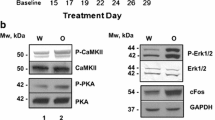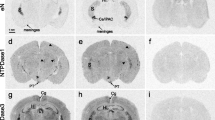Abstract
[D-Ala2,D-Leu5] enkephalin (DADLE) is a synthetic peptide capable of inducing a hibernation-like state in mammals in vivo and in cultured cells in vitro. The effects of DADLE seem to be due to its binding to opioid receptors; however, it inhibits the growth of LNCaP cells, devoid of opioid receptors. We have investigated the effects of DADLE on this cell line using transmission electron microscopy, immunocytochemistry and cytometry, in order to elucidate the general mechanism(s) by which this enkephalin affects cell metabolism. We demonstrated that, similar to cell lines provided with opioid receptors, in LNCaP cells DADLE induces structural modifications of cytoplasmic and nuclear constituents, as well as a decrease in transcription and proliferation. However, DADLE does not provoke an increase in apoptotic or necrotic cell fraction, and, after removing the enkephalin from the culture medium, all effects disappear. We also demonstrated that DADLE molecules enter the cytoplasm and the nucleus of LNCaP cells, mostly binding to perichromatin fibrils and dense fibrillar component, where transcription and early splicing of pre-mRNAs and pre-rRNAs occur. In conclusion, our data demonstrate that the effect of DADLE on transcription and on cultured cells does not depend on opioid receptors. DADLE can, therefore, be envisaged as an extremely promising molecule to be used for inducing a reversible hypometabolic state in various cultured cells, without provoking cell damage or death.




Similar content being viewed by others
References
Ayre M, Zancanaro C, Malatesta M (2004) Morpheus–hypometabolic stasis in humans for long term space flight. JBIS 57:325–339
Baldelli B, Vecchio L, Biggiogera M, Vittoria E, Muzzonigro G, Gazzanelli G, Malatesta M (2004) Ultrastructural and immunocytochemical analyses of opioid treatment effects on PC3 prostatic cancer cells. Microsc Res Tech 64:243–249
Belcheva M, Barg J, Rowinski J, Clark WG, Gloeckner CA Ho A, Gao XM, Chuang DM, Coscia C (1993) Novel opiod binding sites associated with nuclei of NG 108–15 neurohybrid cells. J Neurosci 13:104–114
Bendayan M (1985) Morphometrical and immunocytochemical characterization of pri-insular and tele-insular acinar cells in rat pancreas. Eur J Cell Biol 36:263–268
Benedict PE, Benedict MB, Su TP, Bolling SF (1999) Opiate drugs and delta-receptor-mediated myocardial protection. Circulation 100:357–360
Bernhard W (1969) A new staining procedure for electron microscopical cytology. J Ultrastruct Res 27:250–265
Biggiogera M, Bottone MG, Scovassi AI, Soldani C, Vecchio L, Pellicciari C (2004) Rearrangement of nuclear ribonucleoprotein (RNP)-containing structures during apoptosis and transcriptional arrest. Biol Cell 96:603–615
Biggiogera M, Pellicciari C (2000) Heterogeneous ectopic RNP-derived structures (HERDS) are markers of transcriptional arrest. FASEB J 14:828–834
Bolling SF, Tramontini NL, Kilgore KS, Su TP, Oeltgen PR, Harlow HH (1997) Use of “natural” hibernation induction triggers for myocardial protection. Ann Thorac Surg 64:623–627
Bolling SF, Benedict MB, Tramontini NL, Kilgore KS, Harlow HH, Su TP, Oeltgen PR (1998) Hibernation triggers and myocardial protection. Circulation 98:220–223
Bruce DS, Bailey EC, Setran DP, Tramell MS, Jacobson D, Oeltgen PR, Horton ND, Hellgren EC (1996) Circannual variations in bear plasma albumin and its opioid-like effects on guinea pig ileum. Pharmacol Biochem Behav 53:885–889
Bruce DS, Bailey EC, Crane SK, Oeltgen PR, Horton ND, Harlow HJ (1997a) Hibernation-induction trigger. I. Opioid-like effects of prairie dog plasma albumin on induced contractility of guinea pig ileum. Pharmacol Biochem Behav 58:621–625
Bruce DS, Cox DE, Crane SK, Denholm ML, Dhyanchand RJ, Hampl MJ, Kary JA, Krober AS, Oeltgen PR, Horton ND, Harlow HJ (1997b) Hibernation-induction trigger. II. In vitro effects of prairie dog plasma albumin on mouse vas deferens contractility. Pharmacol Biochem Behav 58:627–630
Cmarko D Verschure PJ Rothblum LI Hernandez-Verdun D, Amalric F, Van Driel R, Fakan S (2000) Ultrastructural analysis of nucleolar transcription in cells microinjected with 5-bromo-UTP. Histochem Cell Biol 113:181–187
Cupo A, Conrath M, Eybalin M, Fourrier O, Zouaoui D, Kaldy P, Herbrecht F (1992) Monoclonal antiidiotypic antibodies against delta opioid receptors as an electron microscopy probe. Eur J Cell Biol 57:273–284
Fakan S (2004) Ultrastructural cytochemical analyses of nuclear functional architecture. Eur J Histochem 48:5–14
Gao B, Hagenbuch B, Kullak-Ublick GA, Benke D, Aguzzi A, Meier P (2000) Organic anion-transporting polypeptides mediate transport of opioid peptides across blood-brain barrier. J Pharmacol Exp Therap 294:73–79
Horoszewicz JS, Leong SS, Kawinski E, Karr JP, Rosenthal H, Chu TM, Mirand EA, Murphy GP (1983) LNCaP model of human prostatic carcinoma. Cancer Res 43:1809–1818
Horton ND, Kaftani DJ, Bruce DS, Bailey EC, Krober AS, Jones JR, Turker M, Khattar N, Su TP, Bolling SF, Oeltgen PR (1998) Isolation and partial characterization of an opioid-like 88 kDa hibernation-related protein. Comp Biochem Physiol B Biochem Mol Biol 119:787–805
Hu H, Miyauchi S, Bridges CC, Smith SB, Ganapathy V (2003) Identification of a novel Na+ and Cl–coupled transport system for endogenous opioid peptides in retinal pigment epithelium and induction of the transport system by HIV-1 Tat. Biochem J 375:17–22
Jacob WA, Bakker A, Hertsens RC, Biermans W (1994) Mitochondrial matrix granules: their behavior during changing metabolic situations and their relationship to contact sites between inner and outer mitochondrial membranes. Microsc Res Tech 27:307–318
Jensen PO, Larsen J, Christiansen J, Larsen JK (1993) Flow cytometric measurement of RNA synthesis using bromouridine labelling and bromodeoxyuridine antibodies. Cytometry 14:455–458
Kampa M, Bakogeorgou E, Hatzoglou A, Damianaki A, Martin P-M, Castanas E (1997) Opioid alkaloids and casomorphin peptides decrease the proliferation of prostatic cancer cell lines (LNCaP, PC3 and DU145) through a partial interaction with opioid receptors. Eur J Pharmacol 335:255–265
Kevelaitis E, Peynet J, Mouas C, Launay J-M, Menaché P (1999) Opening of potassium channels The common cardioprotective link between preconditioning and natural hibernation? Circulation 99:3079–3085
Malatesta M, Zancanaro C, Martin TE, Chan EKL, Amalric F, Lührmann R, Vogel P, Fakan S (1994) Cytochemical and immunocytochemical characterization of nuclear bodies during hibernation. Eur J Cell Biol 65:82–93
Malatesta M, Zancanaro C, Tamburini M, Martin TE, Fu X-D, Vogel P, Fakan S (1995) Novel nuclear ribonucleoprotein structural components in the dormouse adrenal cortex during hibernation. Cromosoma 104:121–128
Malatesta M, Zancanaro C, Marcheggiani F, Cardinali A, Rocchi MBL, Capizzi D, Vogel P, Fakan S, Gazzanelli G (1998) Ultrastructural, morphometrical and immunocytochemical analyses of the exocrine pancreas in a hibernating dormouse. Cell Tissue Res 292:531–541
Malatesta M, Cardinali A, Battistelli S, Zancanaro C, Martin TE, Fakan S, Gazzanelli G (1999) Nuclear bodies are usual constituents in tissues of hibernating dormice. Anat Rec 254:389–395
Malatesta M, Luchetti F, Marcheggiani F, Fakan S, Gazzanelli G (2001a) Disassembly of nuclear bodies during arousal from hibernation: an in vitro study. Chromosoma 110:471–477
Malatesta M, Battistelli S, Rocchi MBL, Zancanaro C, Fakan S, Gazzanelli G (2001b) Fine structural modifications of liver, pancreas and brown adipose tissue mitochondria from hibernating, arousing and euthermic dormice. Cell Biol Int 25:131–138
Malatesta M, Zancanaro C, Baldelli B, Gazzanelli G (2002) Quantitative ultrastructural changes of hepatocyte constituents in euthermic, hibernating and arousing dormice (Muscardinus avellanarius). Tissue Cell 34:397–405
Oeltgen PR, Nilekani SP, Nuchols PA, Spurrier WA, Su TP (1988) Further studies on opioids and hibernation: delta opioid receptor ligant selectively induced hibernation in summer-active ground squirrel. Life Sci 43:1565–1574
Oeltgen PR, Horton ND, Bolling SF, Su TP (1996) Extended lung preservation with the use of hibernation trigger factors. Ann Thorac Surg 61:1488–1493
Reaven E, Tsai L, Maffe B, Azhar S (1993) Effect of okadaic acid on hepatocyte structure and function. Cell Mol Biol Res 39:275–288
Roeder M, Mays RW, Murphy RF (1989) Effect of confluence on endocytosis by 3T3 fibroblasts: increased rate of pinocytosis and accumulation of residual bodies. Eur J Cell Biol 48:37–44
Romita G, Gatti R (1980) Histochemical and ultrastructural aspects of liver in Chiroptera (Vesperugo savi and Rinolophus fe) during different year periods. Acta Bio-Med Ateneo Parmense 51:203–237
Su TP (2000) Delta opioid peptide[D-Ala(2),D- Leu(5)]enkephalin promotes cell survival. J Biomed Sci 7:195–199
Tsao LI, Su TP (2001) Hibernation-induction peptide and cell death: [D-Ala2,D-Leu5]enkephalin blocks Bax-related apoptotic processes. Eur J Pharmacol 428:149–151
Vecchio L, Baldelli B, Malatesta M, Biggiogera M (2003a) Mimicking hibernation: a light and electron microscopic study on in vitro models. Eur J Clin Invest 33/suppl1:49
Vecchio L, Baldelli B, Malatesta M, Biggiogera M (2003b) Modulation of transcription and export in an in vitro model of hibernation. Eur J Histochem 47/suppl1:40
Vecchio L, Soldani C, Bottone MG, Malatesta M, Martin TE, Rothblum LI, Pellicciari C Biggiogera M (2005) DADLE induces a reversible hibernation-like state in HeLa cells. Histochem Cell Biol (in press)
Zancanaro C, Malatesta M, Vogel P, Fakan S (1997) Ultrastructure of the adrenal cortex of hibernating, arousing and euthermic dormouse: Muscardinus avellanarius. Anat Rec 249:359–364
Zancanaro C, Malatesta M, Mannello F, Vogel P, Fakan S (1999) The kidney during hibernation and arousal from hibernation A natural model of organ preservation during cold ischaemia and reperfusion. Nephrol Dial Transplant 14:1982–1990
Acknowledgements
Thanks are due to Mrs. Paola Veneroni for the excellent technical assistance. Cytometric measurements were taken at the Centro Grandi Strumenti of the University of Pavia. B.B. is a PhD student in receipt of a fellowship from the Dottorato di ricerca in Oncologia Urologica (University Politecnica delle Marche).
Author information
Authors and Affiliations
Corresponding author
Rights and permissions
About this article
Cite this article
Baldelli, B., Vecchio, L., Bottone, M.G. et al. The effect of the enkephalin DADLE on transcription does not depend on opioid receptors. Histochem Cell Biol 126, 189–197 (2006). https://doi.org/10.1007/s00418-006-0145-x
Accepted:
Published:
Issue Date:
DOI: https://doi.org/10.1007/s00418-006-0145-x




